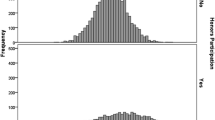Abstract
Using national-level data and a two-step procedure combining least squares regression and logit analysis, this paper examines the impact of majors on college persistence among freshmen. Holding other variables constant, women with business majors and undecided majors are less likely to persist than other women. Women with health majors are most likely to persist. Men with education majors and undecided majors are less likely to persist than other men. Men with business majors are slightly more likely to persist than other men. Differences in persistence rates are explained by differences in the relative magnitudes of goal-commitment, subject-interest, social-forces, and self-image effects. Some policy recommendations are provided.
Similar content being viewed by others
References
Astin, A.W. (1972). College Dropouts: A National Profile. Washington, DC: American Council on Education.
Astin, A.W. (1975). Preventing Students from Dropping Out. San Francisco: Jossey-Bass.
Attinasi, L.C., Jr. (1989). ‘Getting In: Mexican Americans' perceptions of university attend-ance and the implications for freshman year persistence’, Journal of Higher Education 60(3), 247–277.
Bean, J.P. and Metzner, B.S. (1985). ‘A conceptual model of nontraditional undergraduate student attrition’, Review of Educational Research 55(4), 485–540.
Betz, N. and Fitzgerald, L.F. (1987). The Career Psychology of Women. Orlando: Academic Press, Inc.
Cabrera, A.F., Nora, A. and Castaneda, M.B. (1993). ‘College persistence: structural equations modeling of an integrated model of student retention’, Journal of Higher Education 64(2), 123–139.
Corcoran, M.E. and Courant, P.N. (1985). ‘Sex role socialization and labor market outcomes’, American Economic Review 75(2), 275–278.
Davies, S. and Guppy, N. (1997). ‘Fields of study, college selectivity, and student inequalities in higher education’, Social Forces 75(4), 1417–1438.
Douvan, E. (1976). ‘The role of models in women's professional development’, Psychology of Women Quarterly 1(1), 5–15.
Ehrenberg, R.G. and Sherman, D.R. (1987). ‘Employment while in college, academic achievement, and postcollege outcomes’, Journal of Human Resources 22(1), 1–23.
Green, K.C. (1992). After the Boom: Management Majors in the 1990s.NewYork,NY: McGraw Hill.
Grosset, J.M. (1991). ‘Patterns of integration, commitment, and student characteristics and retention among younger and older students’, Research in Higher Education 32(2), 159–178.
Hackett, G., Esposito, D. and O'Halloran, M.S. (1989). ‘The relationship of role model influ-ences to the career salience and educational and career plans of college women’, Journal of Vocational Behavior 35(2), 164–180.
Okun, M.A., Benin, M. and Brandt-Williams, A. (1996). ‘Staying in college: moderators of the relation between intention and institutional departure’, Journal of Higher Education 67(5), 577–596.
Pascarella, E.T. and Terenzini, P.T. (1980). ‘Predicting freshman persistence and voluntary dropout decisions’, Journal of Higher Education 51(1), 60–75.
Robst, J., Keil, J. and Russo, D. (1998). ‘The effect of gender composition on student retention’, Economics of Education Review 17(4), 429–439.
Spady, W.G. (1970). ‘Dropouts from higher education: An interdisciplinary review and synthesis’, Interchange 1(1), 64–85.
Spady, W.G. (1971). ‘Dropouts from higher education: toward an empirical model’, Inter-change 2(3), 38–62.
Tinto, V. (1993). Leaving College: Rethinking the Causes and Cures of Student Attrition. Chicago: The University of Chicago Press.
Tinto, V. (1997). ‘Classrooms as communities’, The Journal of Higher Education 68(6), 599–623.
Turner, S.E. and Bowen, W.G. (1999). ‘Choice of major: the changing (unchanging) gender gap’, Industrial and Labor Relations Review 52(2), 289–313.
Ware, N.C. and Lee, V.E. (1988). ‘Sex differences in choice of college science majors’, American Educational Research Journal 25(4), 593–614.
Ware, N.C., Steckler, N.A. and Leserman, J. (1985). ‘Undergraduate women: Who chooses a science major?’, Journal of Higher Education 56(1), 73–84.
Author information
Authors and Affiliations
Rights and permissions
About this article
Cite this article
Leppel, K. The impact of major on college persistence among freshmen. Higher Education 41, 327–342 (2001). https://doi.org/10.1023/A:1004189906367
Issue Date:
DOI: https://doi.org/10.1023/A:1004189906367




